If the sun were to suddenly stop providing energy to Earth, most ecosystems would vanish. Which of the following ecosystems would likely survive the longest after this hypothetical disaster?
A.desert
B.benthic ocean
C.tropical rain forest
D.tundra
B
Which of the following terms encompasses all of the others?
A.heterotrophs
B.carnivores
C.herbivores
D.primary consumers
A
To recycle nutrients, an ecosystem must have, at a minimum, _____.
A.producers, primary consumers, secondary consumers, and
decomposers
B.producers
C.producers, primary consumers, and
decomposers
D.producers and decomposers
D
Which of the following is an example of an ecosystem?
A.the intricate interactions of the various plant and animal species
on a savanna during a drought
B.the plants, animals, and
decomposers that inhabit an alpine meadow
C.all of the organisms
and their physical environment in a tropical rain forest
D.all of
the brook trout in a 500-square-hectare river drainage system
C
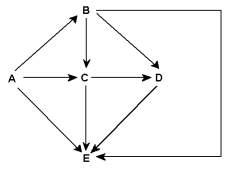
Examine this food web for a particular terrestrial ecosystem. Which species is autotrophic?
A.A
B.C
C.D
D.E
A
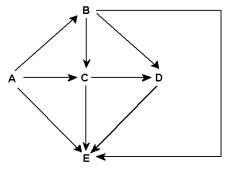
Examine this food web for a particular terrestrial ecosystem. Which species is most likely a decomposer on this food web?
A.A
B.B
C.C
E.E
E
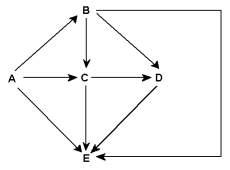
Examine this food web for a particular terrestrial ecosystem. Species C is toxic to predators. Which species is most likely to benefit from being a mimic of C?
A.A
B.B
C.C
D.E
B
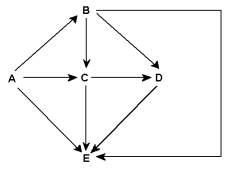
Examine this food web for a particular terrestrial ecosystem. Which pair of species could be omnivores?
A.A and D
B.B and C
C.C and D
D.C and E
D
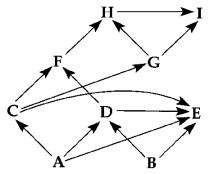
If the figure above represents a marine food web, the smallest organism might be _____.
A.A
B.C
C.I
D.E
A
Which of the following organisms is INCORRECTLY paired with its trophic level?
A.grasshopper – primary consumer
B.zooplankton – primary
producer
C.fungus – detritivore
D.cyanobacterium – primary producer
B
Which of the following has the greatest effect on the rate of
chemical cycling in an
ecosystem?
A.the rate of decomposition in the ecosystem
B.the ecosystem's
rate of primary production
C.the production efficiency of the
ecosystem's consumers
D.the trophic efficiency of the ecosystem
A
Matter is gained or lost in ecosystems. How does this occur?
A.Heterotrophs convert heat to energy.
B.Photosynthetic
organisms convert solar energy to sugars.
C.Chemoautotrophic
organisms can convert matter to energy.
D.Matter can be moved
from one ecosystem to another.
D
The relationship between biomass and primary productivity is that _____.
A.biomass is the rate of primary productivity
B.biomass is the
inverse of primary productivity
C.biomass is the natural log of
primary productivity
D.primary productivity is the inverse of
biomass
E.primary productivity is the rate at which biomass is produced
E
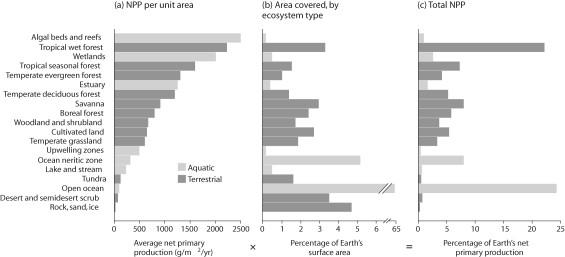
Which category in the figure above makes available the highest productivity per square meter?
A.open ocean
B.algal beds and
reefs
C.wetlands
D.tropical wet forest
B
Considering its total area covered, which ecosystem type represented in the figure above has a very low level of economic impact on Earth's ecosystem?
A.rock, sand, and ice
B.tropical wet forest
C.tropical
seasonal forest
D.ocean neritic zone
A
Why is terrestrial productivity higher in equatorial climates?
A.Productivity increases with temperature.
B.Productivity
increases with available sunlight.
C.Productivity increases with
water availability.
D.The answer is most likely a combination of
the other responses.
D
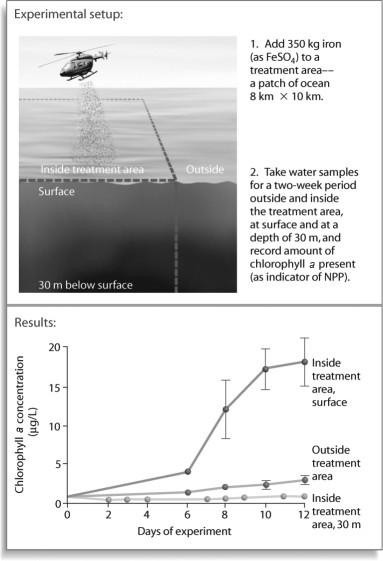
After looking at the experiment in the figure above, what can be said about productivity in marine ecosystems?
A.Iron can be a limiting nutrient in
productivity.
B.Productivity increases when chlorophyll a is
added.
C.Nothing can be said based on this
information.
D.Marine organisms break down iron for energy and
thus for productivity.
A
During a year, plants never use 100% of the incoming solar radiation
for photosynthesis. What is a reasonable explanation for this?
I)
Plants cannot photosynthesize as well during winter (in cold winter
climates).
II) Plants cannot photosynthesize as well on cloudy
days.
III) The pigments that drive photosynthesis respond to only
a fraction of the wavelengths that are available.
A.only I
B.only II
C.only III
D.I, II, and III
D
Suppose you are studying the nitrogen cycling in a pond ecosystem over the course of a month. While you are collecting data, a flock of one hundred Canada geese lands and spends the night during a fall migration. What could you do to eliminate error in your study as a result of this event?
A.Find out how much nitrogen is eliminated by a Canada goose over
about a twelve-hour period, multiply this number by 100, and subtract
that amount from the total nitrogen in the ecosystem.
B.Put a net
over the pond so that no more migrating flocks can land on the pond
and alter the nitrogen balance of the pond.
C.Find out how much
nitrogen is consumed in plant material by a Canada goose over about a
twelve-hour period, multiply this number by 100, and add that amount
to the total nitrogen in the ecosystem.
D.Find out how much
nitrogen is consumed and eliminated by a Canada goose over about a
twelve-hour period and multiply this number by 100; enter this +/-
value into the nitrogen budget of the ecosystem.
D
As big as it is, the ocean is nutrient-limited. If you wanted to investigate this phenomenon, one reasonable approach would be to _____.
A.observe Antarctic Ocean productivity from year to year to see if
it changes
B.compare nutrient concentrations between the photic
zone and the benthic zone in various marine locations
C.contrast
nutrient uptake by autotrophs in marine locations that are different
temperatures
D.experimentally enrich some areas of the ocean and
compare their productivity to that of untreated areas
D
Which of the following is a true statement regarding mineral nutrients in soils and their implication for primary productivity?
A.Phosphorous is sometimes unavailable to producers due to
leaching.
B.Alkaline soils are more productive than acidic
soils.
C.Adding a nonlimiting nutrient will stimulate primary
productivity.
D.Globally, phosphorous availability is most
limiting to primary productivity.
A
Why is net primary production (NPP) a more useful measurement to an ecosystem ecologist than gross primary production (GPP)?
A.NPP shows the rate at which the standing crop is utilized by
consumers.
B.NPP represents the stored chemical energy that is
available to consumers in the ecosystem.
C.NPP can be expressed
in energy/unit of area/unit of time.
D.NPP can be expressed in
terms of carbon fixed by photosynthesis for an entire ecosystem.
B
How is net ecosystem production (NEP) typically estimated in ecosystems?
A.the rate of decomposition by detritivores
B.the amount of
heat energy released by the ecosystem
C.the annual total of
incoming solar radiation per unit of area
D.the net flux of
carbon dioxide or oxygen in or out of an ecosystem
D
How is it that satellites can detect differences in primary productivity on Earth?
A.Satellites compare the wavelengths of light captured and reflected
by photoautotrophs in different ecosystems.
B.Satellite
instruments can detect reflectance patterns of the photosynthetic
organisms of different ecosystems.
C.Sensitive satellite
instruments can measure the amount of NADPH (nicotinamide adenine
dinucleotide phosphate) produced in the summative light reactions of
different ecosystems.
D.Satellites detect differences by
measuring the amount of water vapor emitted by transpiring producers.
A
Acid precipitation lowered the pH of soil in a terrestrial ecosystem that supported a diverse community of plants and animals. The decrease in pH eliminated all nitrogenfixing bacteria populations in the area. Which prediction most accurately reflects the impact this will have on the community?
A.The decrease in pH actually increases the availability of soil
nutrients, so other nutrients that were less available cause an
increase in primary production and an increase in biomass at other
trophic levels.
B.Primary producers will suffer from nitrogen
deficiency and the entire community will experience a decrease in
carrying capacity.
C.Plants can obtain the nitrogen necessary for
growth from the atmosphere, but bacterial communities will be
negatively impacted.
D.Since phosphorus can replace nitrogen as
an essential nutrient, the impact will be minimal.
B
_____ are secondary consumers.
A.Producers
B.Herbivores
C.Plants
D.Cows
E.Carnivores
E
Approximately _____% of the energy at one trophic level is passed on to the next highest trophic level.
A.0–5
B.5–10
C.10–15
D.15–20
E.90–100
B
10,000 kcal of producer could support approximately _____ kcal of tertiary consumer.
A.1,000
B.100
C.10
D.1
E.0
C
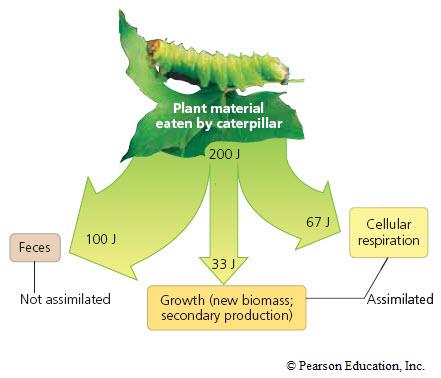
Approximately what percentage of the energy in the caterpillar’s food
is actually used for secondary production (growth)?
Approximately
what percentage of the energy in the caterpillar’s food is actually
used for secondary production (growth)?
A.17%
B.34%
C.50%
D.100%
A
Why is a diagram of energy flow from trophic level to trophic level shaped like a pyramid?
A.Organisms at each level store most of the energy and pass little
on.
B.There are more producers than primary consumers, and so
on.
C.Organisms eventually die.
D.Most energy at each level
is lost, leaving little for the next.
E.Secondary consumers are
larger than primary consumers, and so on.
D
h one of the following correctly ranks these organisms in order from lowest to highest percent in production efficiency?
A.mammals, insects, fish
B.insects, fish,
mammals
C.mammals, fish, insects
D.fish, insects, mammals
C
Owls eat rats, mice, shrews, and small birds. Assume that, over a period of time, an owl consumes 5000 J of animal material. The owl loses 2300 J in feces and owl pellets and uses 2500 J for cellular respiration. What is the production efficiency of this owl?
A.0.2%
B.4%
C.0.02%
D.40%
B
After looking at the figure above, what can be said about productivity in this ecosystem?
A.Productivity increases with each trophic level.
B.Between 80%
and 90% of the energy is lost between most trophic
levels.
C.Nothing can be said based on this
information.
D.Between 10% and 20% of the energy is lost between
most trophic levels.
B
How does inefficient transfer of energy among trophic levels result in the typically high endangerment status of many top-level predators?
A.Predators have relatively large population sizes.
B.Predators
are more disease-prone than animals at lower trophic
levels.
C.Top-level predators are destined to have small
populations that are sparsely distributed.
D.Top-level predators
are more likely to be stricken with parasites.
C
Why does a vegetarian leave a smaller ecological footprint than an omnivore?
A.Eating meat is an inefficient way of acquiring photosynthetic
productivity.
B.Fewer animals are slaughtered for human
consumption.
C.There is an excess of plant biomass in all
terrestrial ecosystems.
D.Vegetarians need to ingest less
chemical energy than omnivores.
A
For most terrestrial ecosystems, pyramids composed of species abundances, biomass, and energy are similar in that they have a broad base and a narrow top. The primary reason for this pattern is that _____.
A.at each step, energy is lost from the system
B.top carnivores
and secondary consumers have a more general diet than primary
producers
C.biomagnification of toxic materials limits the
secondary consumers and top carnivores
D.secondary consumers and
top carnivores require less energy than producers
A
Which of the following is primarily responsible for limiting the number of trophic levels in most ecosystems?
A.Decomposers compete with higher-order consumers for nutrients and
energy.
B.Nutrient cycling rates tend to be limited by
decomposition.
C.Energy transfer between trophic levels is
usually less than 20 percent efficient.
D.Many primary and
higher-order consumers are opportunistic feeders.
C
Which trophic level is most vulnerable to extinction?
A.tertiary consumer level
B.producer level
C.secondary
consumer level
D.primary consumer level
A
Consider the food chain of grass → grasshopper → mouse → snake → hawk. About how much of the chemical energy fixed by photosynthesis of the grass (100 percent) is available to the hawk?
A.0.1%
B.0.01%
C.1%
D.10%
B
An ecosystem is unlikely to be limited by the supply of _____ because it is obtained from the air.
A.water
B.carbon
C.phosphorus
D.calcium
E.nitrogen
B
Biogeochemical cycles are crucial to ecosystem function because _____.
A.they keep the planet warm enough for living things to
survive
B.nutrients and other life-sustaining molecules are in
limited supply and must be continually recycled
C.energy flows
through ecosystems in one direction only and is eventually dissipated
as heat
D.they remove poisons and keep them locked up in
"sinks"
E.they prevent catastrophic extinctions
B
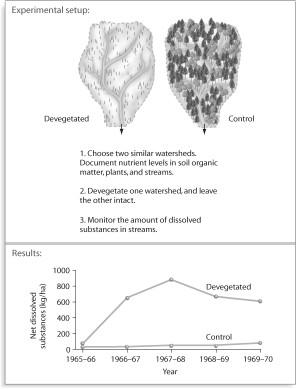
Based on the experiment in the figure above, which of the following
are plausible reasons for the result?
I) No nutrients evaporate
now that vegetation is absent.
II) Nutrients dissolve in the
water running through the watershed.
III) Nutrients are attached
to small particles of sand or clay that leave the watershed.
IV)
Plant roots that held soil particles in place are no longer there.
A.only I, II, and IV
B.only II, III, and IV
C.only II and
IV
D.only I and III
B
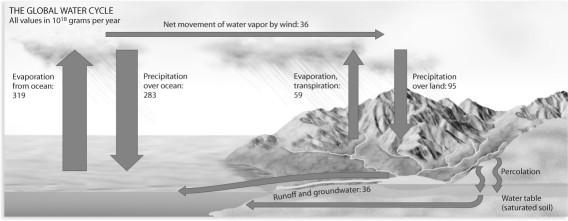
Consider the global water cycle depicted in the figure above. Which one of the reserves contains the smallest percentage of global water?
A.atmosphere
B.polar ice caps
C.glaciers
D.rivers and lakes
A
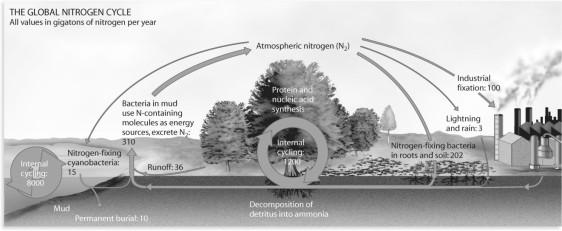
Consider the global nitrogen cycle depicted in the figure above. What is the limiting portion of the cycle for plants?
A.nitrogen lost to the atmosphere
B.industrial nitrogen
fixation
C.internal nitrogen cycling in the
oceans
D.nitrogen fixation by bacteria
D
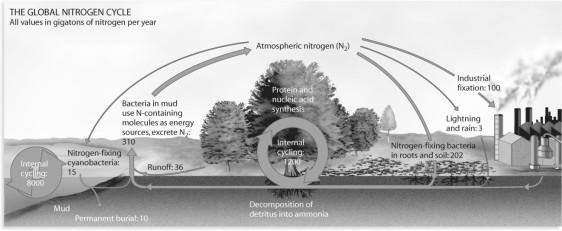
Consider the global nitrogen cycle depicted in the figure above. How are humans altering this cycle?
A.industrial nitrogen fixation
B.nitrogen lost to the
atmosphere
C.reduction of nitrogen available to terrestrial
ecosystems
D.reduction of nitrogen fixation by bacteria
A
Which of the following locations are major reservoirs for carbon for
the carbon cycle?
I) atmosphere
II) sediments and
sedimentary rocks
III) fossilized plant and animal remains (coal,
oil, and natural gas)
IV) plant and animal biomass
A.only I and III
B.only II and IV
C.I, II, III, and
IV
D.only II, III, and IV
C
Which of the following statements is correct about biogeochemical cycling?
A.The phosphorus cycle involves the recycling of atmospheric
phosphorus.
B.The nitrogen cycle involves movement of diatomic
nitrogen between the biotic and abiotic components of the
ecosystem.
C.The carbon cycle has maintained a constant
atmospheric concentration of carbon dioxide for the past million
years.
D.The phosphorus cycle involves the weathering of rocks.
D
The Hubbard Brook watershed deforestation experiment revealed that
_____.
I) deforestation increased water runoff
II) nitrate
concentration in waters draining the deforested area became
dangerously high
III) calcium levels remained high in the soil of
deforested areas
A.only I
B.only II
C.only III
D.only I and II
D
Why do logged tropical rain forest soils typically have nutrient-poor soils?
A.Most of the nutrients in the ecosystem are removed in the
harvested timber.
B.Logging results in soil temperatures that are
lethal to nitrogen-fixing bacteria.
C.The cation exchange
capacity of the soil is reversed as a result of
logging.
D.Tropical bedrock contains little phosphorous.
A
The discipline that applies ecological principles to returning degraded ecosystems to a more natural state is known as _____.
A.landscape ecology
B.conservation ecology
C.restoration
ecology
D.resource conservation
C
Which of the following would be considered an example of bioremediation?
A.adding seeds of a chromium-accumulating plant to soil contaminated
by chromium
B.adding nitrogen-fixing microorganisms to a degraded
ecosystem to increase nitrogen availability
C.dredging a river
bottom to remove contaminated sediments
D.using a bulldozer to
regrade a strip mine
B
The goal of restoration ecology is to _____.
A.prevent further degradation by protecting an area with park
status
B.return degraded ecosystems to a more natural
state
C.replace a ruined ecosystem with a more suitable ecosystem
for that area
D.manage competition between species in
human-altered ecosystems
B